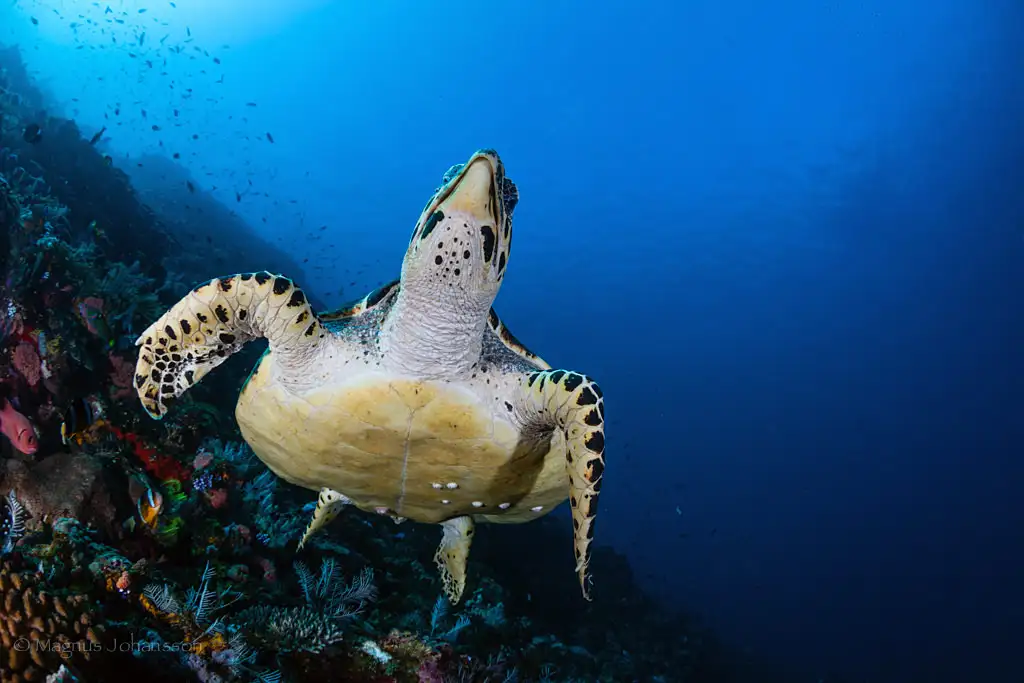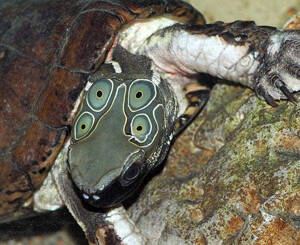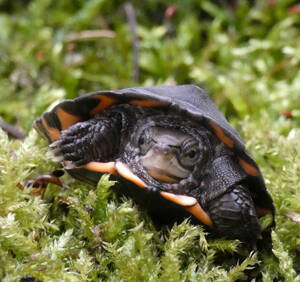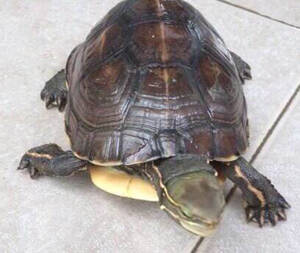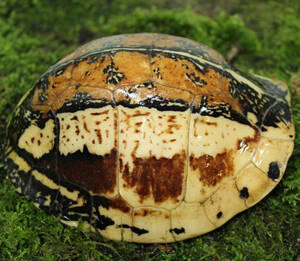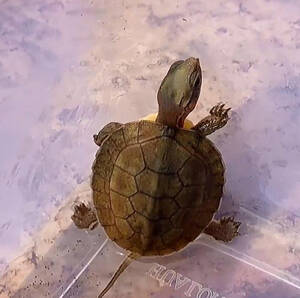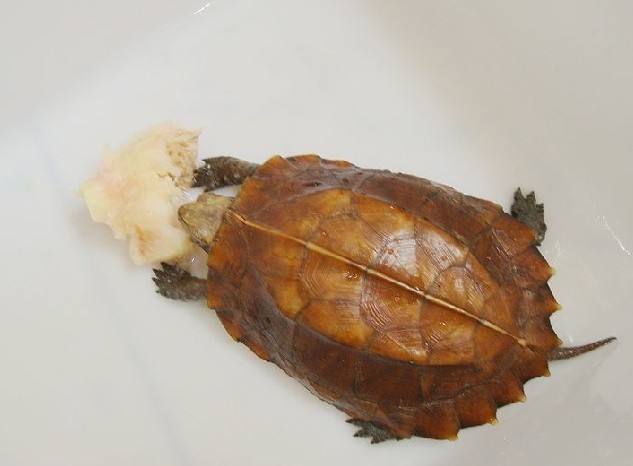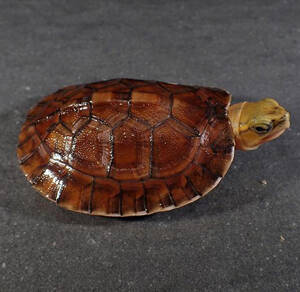Cuora flavomarginata
IUCN
LCBasic Information
Scientific classification
- name:Cuora flavomarginata
- Scientific Name:Cuora flavomarginata,Yellow-margined Box Turtle, splint turtle, snake-killing turtle, broken plate turtle, yellow-margined box turtle
- Outline:Testudines
- Family:Testudinidae B.turtle
Vital signs
- length:11-20cm
- Weight:400-500g
- lifetime:40-60years
Feature
Likes to live in groups and is not afraid of people
Distribution and Habitat
Yellow-margined box turtles are distributed in China, Japan (Kyushu Island), and the Ryukyu Islands. In China, they are distributed in the central and southern mountainous areas of Anhui, Jiangsu, Shanghai, Zhejiang, Henan, Hubei, Hunan, Fujian, Guangdong, Hong Kong, and Taiwan. In Anhui, they are mainly distributed in southern Anhui and the Dabie Mountain area as well as hilly areas.
In nature, yellow-margined box turtles live in forest edges, weeds, and shrubs in hilly and mountainous areas. They like to live in groups. During the day, they hide under quiet, dark, and humid tree roots and in stone crevices. It is common to see multiple turtles in the same cave, where they move in the dark but not far from clean water sources. The living temperature is 0-43℃, and its diurnal activity rhythm varies with the seasons. When the temperature is 18-24℃ in April-May and September-October, there is less activity in the morning and evening, and more activity around noon; when the temperature
Appearance
The head of the yellow-margined box turtle is smooth and scaleless, with a round and clear eardrum. The back of the head is light olive, the front of the snout is flat, the upper beak is obviously curved, the lower jaw is orange-red, and there is a wide golden stripe behind each eye. The two stripes meet on the back of the head to form a "U"-shaped arc. The neck behind the stripe is light orange-red. The carapace is crimson or brown-red, high and raised, with a light yellow ridge in the middle. The shell height is about 1/2 of the shell length. The marginal shield of the carapace is slightly upturned, and there are clearer concentric rings on the shield. The plastron is brown-black, and the outer edge and the ventral surface of the marginal shield are beige. The front edge of the plastron is slightly protruding, and the rear edge is elliptical. There are no notches on the front and back edges. The carapace and the plastron, and the front and back parts of the plastron are con
Details
Yellow-margined Box Turtle has two subspecies.
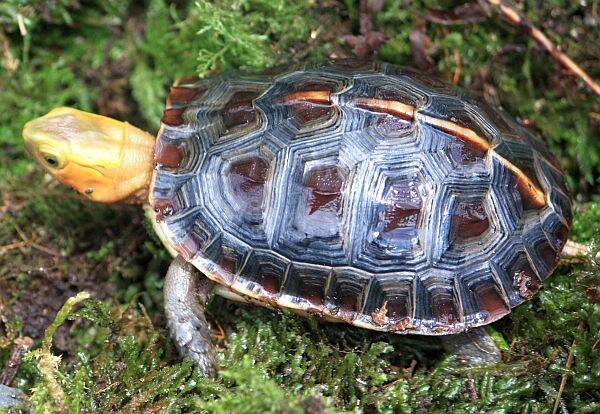
Yellow-margined Box Turtle is bolder than other freshwater turtles and is not afraid of people. Except for the mating season, it rarely fights with its own kind. After one month of domestication, individuals can develop the habit of eating at regular times and places; they like cleanliness and often go to clean water sources for bathing and drinking water after a full meal; after 2 to 3 months of domestication, they can crawl with their owners when lured by food.
Yellow-margined box turtles are omnivorous turtles that mainly eat meat. In the wild, they feed on insects, worms, and mollusks, such as longhorn beetles, golden leafworms, centipedes, geckos, snails, etc. When animal bait is scarce, they also eat cereals and fruits and vegetables. In the starvation test, some individuals can even eat rotten plant leaves. When artificially bred, they like to eat earthworms, mealworms, maggots, animal meat, and ball-shaped eel feed and granular yellow eel feed. They do not like to eat dead fish and shrimp with skin, and they also prey on small live fish in shallow water.
The suitable temperature for feeding of the yellow-margined box turtle is 20-33℃, but the feeding intensity is the highest at 28-30℃. The amount of food consumed is closely related to the temperature. When the temperature is lower than 26℃, the amount of food consumed decreases significantly. According to domestication observations, when the ambient temperature is 20-24℃, the amount of food consumed is less than 1% of the body weight, and the number of times of feeding is small, generally once every 2-3 days; when the ambient temperature is 25-27℃, the amount of food consumed can reach 1-2% of the body weight, generally once every 1-2 days; when the ambient temperature is stable at 28-31℃, the amount of food consumed is 2.5-5% of the body weight, generally once a day.
Because temperature directly affects the amount of food consumed by the yellow-margined box turtle, temperature also directly affects its growth rate. Yellow-margined box turtles eat the most from June to September and grow fast. Under natural conditions, it usually takes 5 to 6 years to reach sexual maturity, and the weight can reach 400 to 500 grams. Artificial breeding can increase its growth rate. According to the weight gain statistics of the domesticated test group from July to September 1999, the highest value of its monthly weight gain can reach 10 to 15%. Yellow-margined box turtles grow slowly in nature, mainly because of their slow movements, poor ability to prey on animals, and insufficient food intake. At the same time, the annual feeding season is short. During the non-hibernation period, bait and temperature are the direct factors affecting their growth rate.
Male and female turtles can be identified by appearance. The female turtle's plastron is straight, the tail is thick and short, the body has no odor, and the trunk is short and thick; the male turtle's plastron is slightly concave, the tail is slender, the trunk is long and thin, and has a bad smell, which can attract the opposite sex to mate and reproduce during the breeding season.
Yellow-margined box turtles usually mate in the grass from mid-April. The egg-laying season is from late May to mid-September, and the peak period is from June to July, with 1 to 5 eggs. The eggs are laid in batches from mid-June to late July. The egg shell is grayish white, oblong, 40 to 46 mm long, 20 to 26 mm wide, and weighs 8.5 to 18.6 grams. The size of the egg is related to the parent. The eggs are usually laid in loose sand near the water, mostly in the early morning and evening. When laying eggs, they first use their hind legs to dig a hole about 3 cm deep, support it with their forelimbs and do not move. After laying, they use their hind legs to dig sand in a semi-arc shape to cover the eggs. The sand covered is slightly higher than the flat ground, so it is easier to find the egg-laying hole. There are also yellow-margined box turtles that cannot find suitable sand to lay eggs, and lay eggs in weeds or in breeding ponds. Some uncovered eggs are eaten by themselves. Therefore, artificially bred box turtles need to build a good egg-laying site with loose sand on the bank of the breeding pond to increase the reproduction rate.
The number of wild populations of yellow-margined box turtles in various distribution areas is already very rare, and the population is close to the brink of extinction.
Due to the continuous destruction of the habitat of wild yellow-margined box turtles and the intensification of human hunting activities, the number of wild populations has continued to decline. In addition, the artificial breeding capacity of the turtle is low, the scale of artificial breeding is small, and the number of turtles available in the market is limited, which makes the price of yellow-margined box turtles rise year by year. The rise in market prices has further led to the extinction-level hunting of the turtle in its place of origin. Many residents in mountainous areas have long been engaged in poaching of yellow-margined box turtles. Poaching tools and traps have been found many times in various places, and some poaching devices are very new. These all indicate that poaching activities targeting yellow-margined box turtles have always existed in some places and have not been effectively stopped.
Yellow-margined box turtles can be eaten, used as medicine and for viewing. In Suzhou, this turtle is made into "broken board turtle slices" and "broken board injection". The former is used to treat bone tuberculosis, joint tuberculosis and lymph node tuberculosis. In addition to treating various tuberculosis, the latter can also treat internal and external hemorrhoid bleeding, fistulas and be used as a cancer adjuvant. In addition, it has a role in promoting the decrease in white blood cell count caused by chemotherapy.
Listed in the "Red List of Endangered Species of the World Conservation Union" (IUCN 2000 ver 3.1) - Endangered (EN).
Listed in Appendix II of the Convention on International Trade in Endangered Species of Wild Fauna and Flora (CITES).
Listed in the National List of Key Protected Wildlife - Level 2.
Listed in the China Biodiversity Red List - Vertebrate Volume (Reptiles) - Critically Endangered (CR).
Listed in the China Red Data Book of Endangered Animals - Endangered (EN).
Listed in the "National List of Terrestrial Wildlife with Important Economic and Scientific Research Value" issued by the State Forestry Administration of China on August 1, 2000.
Anhui, Jiangsu, Henan and other provinces in China have also included the yellow-margined box turtle in the "List of Local Key Protected Wildlife".
Protect wild animals and eliminate game.
Maintaining ecological balance is everyone's responsibility!

